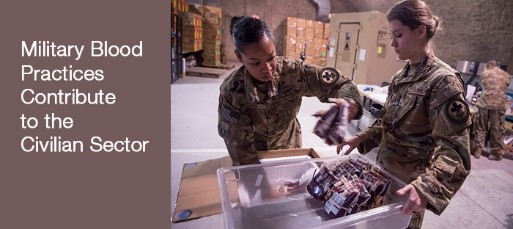 Photo courtesy of health.mil, the official website of the Military Health System
Photo courtesy of health.mil, the official website of the Military Health System
Research into blood transfusion began back in the 17th century, with experimentation continuing into the 19th century, when the A, B, and O blood groups were discovered. Early in the 20th century it was proposed that donor and patient blood should be typed and cross matched prior to a transfusion. But it wasn’t until World War II that blood transfusions were first used on a large scale to treat wounded soldiers.1
Since that time, a great deal has been learned. Soldiers injured on the battlefield have benefited as military expertise has grown. These advancements have also helped the civilian sector. AABB News recently published an article called “Military Practices Have Led to Improvements in Providing Blood in Crisis Situations in the Civilian Sector.”
One example of a military best practice that has influenced the civilian sector is the need to not only plan for direct consequences of a disaster, but also to plan for secondary consequences, like a shortage of donors or staff (as might be the case during a pandemic). Other examples include research on extending the shelf life of blood products and innovations in product shipping. Another advance is earlier intervention for trauma patients, leading to civilian ambulances and helicopters carrying blood and plasma for transfusion during transport.
Helmer Scientific supports blood centers and hospitals, the patients they serve, and their efforts to keep the blood supply safe. We have offered high quality blood storage equipment for 40 years and are here to help you to properly store and monitor your blood products. To read the full article, click the link below:
References
1 History of Blood Transfusion, https://www.news-medical.net/health/History-of-Blood-Transfusion.aspx
Other Blogs You Might Be Interested In...
Emergency Medical Services Save Lives by Transfusing Blood Prior to Arrival at Hospital
Storing Blood in the ER - Supporting Hospital Disaster Control Resuscitation Policies
Improving ER Access to Emergency Blood
Zipline and Helmer Scientific Partner to Save Lives in Rwanda




